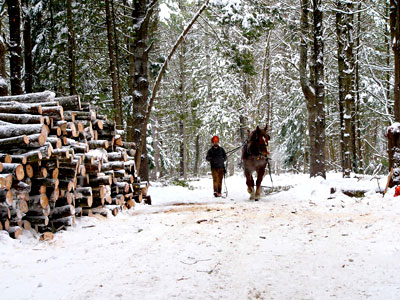 |
| Working in the woods when the soil is frozen and covered with snow is one way to limit soil compaction. Photo of Brad Johnson and Sal by Jennifer Glick. |
By Andy McEvoy
As the name Low-Impact Forestry suggests, all forest practices have some impact. However, making informed decisions, planning for the long term, and implementing best management practices can always help forest practitioners reduce the known harmful impacts of logging.
Soil health is the foundation for healthy, productive forests, and good tools and practices can reduce damage done to soils by compaction and rutting. Forests become mature and towering only if they grow on mature, intact soil. Harvesting wood can promote maturing forests and even increase forest health – but harvest practices can undo those benefits by damaging soils.
Almost all logging scenarios, from machines to draft animals, involve some significant soil compaction. The force of a falling tree alone can leave a lasting impact. Most often, though, significant soil compaction results from dragging logs and from the pressure exerted by equipment traveling on skid trails and roads. Downward pressure compresses soil particles and the pore spaces between them, harming soil structure. These effects are not always as obvious as deep ruts. In some soils, compaction may not become apparent until its effects are apparent – i.e., plants are not regenerating. Soil compaction is not irreversible but takes many years to undo.
A state as diverse as Maine has many soil types, which respond differently and differ in susceptibility to compaction. Generally, drier, sandy soils are less susceptible than wetter, more loam-like soils. Clay soils are very susceptible to compaction. Knowing your forest’s soil type(s) is essential when planning where and when to perform certain forestry activities. Any management plan should include maps of soil types, just as it would map stand types based on tree species. The location of various soils in the woodlot determines when and where management occurs. For instance, a sandy oak-pine woodlot in southwestern Maine might be a little more forgiving of soil compaction than a rich, loamy hardwood lot in the Kennebec Valley.
No matter the type, soil plays an essential role in water retention and in the movement of oxygen and nutrients. The ability of soil to absorb and disperse water prevents flooding and erosion that would otherwise impinge on tree health. When soils become compacted, water is not absorbed so readily; instead, it flows across the surface of the ground, is inaccessible to tree roots, and often washes away nutrient-rich topsoil. Once water begins to flow across the surface, it will continue to do so, carving a small stream bed and displacing soil over time.
Destroying soil structure also harms the microorganisms that have beneficial relationships with trees. In many cases, these organisms help move nutrients to tree roots, and they may play a role in defending plants against pests. These organisms cannot survive in overly compacted soils, so their critical relationship with the vegetation is lost.
Although all logging involves some soil compaction, a good logger will reduce the surface area of the woodlot affected and the level of compaction on that area as much as possible – by operating when the ground is dry; even better, frozen; and better yet, frozen with an insulating layer of snow. Remember that wetter soils are more susceptible to compaction, and sandier soils tolerate logging work in wet conditions better than heavier soils.
Different equipment affects soil structure differently, too. Obviously, heavier machines have less room for error when considering the ground conditions. Helpful innovations and methods for reducing compaction include high flotation tires that distribute a machine’s pressure over a larger area; tracked rather than rubber-wheeled machines; and draft animals. Although the log arches and sleds used in draft animal logging can exert a lot of force on the ground, the scale at which most draft-powered operations work is small enough that compaction is minor. As always, the ability to mitigate soil compaction is not so much about the particular tool used, but about how the tool is used.
As in farms and gardens, soil is the foundation of the health of a forest. When trees seem to be in decline, we often look up into the crown for the source of damage – for ice scars, wind damage, fungi and insects – but we should probably look down at the soil. Even if a tree is infected by fungi or insects, its ability to heal and maintain its health depends on its access to water and nutrients from the ground. Healthy trees produce chemicals to ward off invaders and repair physical trauma. When soil compaction suppresses their ability to combat illness, every other ailment is more damaging.
Soil compaction has long been the scourge of forestry activities. Area-wide compaction often goes unnoticed while ruts attract the negative attention. But for long-term woods management goals, maintaining soil structure is the most important consideration. Thorough planning can restrict the compacted surface area and reduce the level of compaction in those areas. Your woods will thank you for your diligence.
Andy McEvoy was MOFGA’s low-impact forestry coordinator in 2011.
For information about MOFGA’s low-impact forestry program, contact [email protected] or visit our Low-Impact Forestry webpage.
